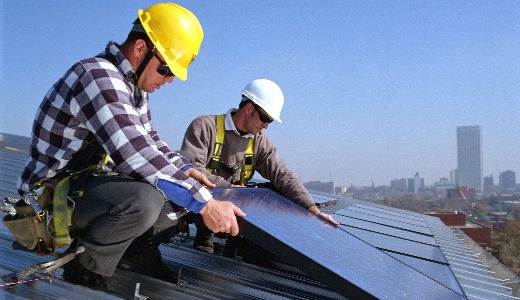
(Apollo News Service) Earning the title “Indianapolis Green Technician” means more than simply passing a certification exam. The first graduates of the Green Technician training program also built and installed an array of solar panels and a wind turbine at the Electrical Training Institute (ETI), where the program is offered. This renewable energy, a testament to the ETI’s emphasis on practical, hands-on experience, will power the Institute’s future training efforts.
Only a year old, the 128-hour alternative energy apprenticeship program already has a “longer waiting list than any of our other classes,” said the ETI’s director, Jim Patterson. As a joint partnership between the National Electrical Contractors Association of Central Indiana and the International Brotherhood of Electrical Workers (IBEW) Local 481, it reflects the growing consensus between labor and management that workers’ skills need to keep up with Indiana’s rapidly growing clean energy economy.
The tangible benefits of the Green Technician program are quickly becoming clear. “We’re starting to see the fruits of our efforts first-hand,” said Andre Grocox, an ETI graduate who, with Patterson, is the driving force behind the Green Technician program. As the project manager of the electrical contractor ERMCO Inc.’s Green Energy Group, Grocox recently landed a contract for installing solar panels on the roof of the Bean Federal Center in Fort Benjamin Harrison – Indiana’s largest rooftop solar installation to date. ERMCO beat out four non-union contractors for the project, capturing “millions of dollars worth of labor” for IBEW Local 481 members.
With the unemployment rate in union construction hovering around 25 percent – more than twice that of the broader economy – every opportunity to install renewable energy systems or retrofit buildings matters. Construction jobs are particularly hard to come by in a tough economy, as companies cut back on expansion, explained Grocox. When new projects do eventually emerge, they generally require 12 to 18 months of planning before jobs start to materialize. While Grocox has seen his competitors falter, ERMCO’s gotten “quite a bit of work.” He estimates that upwards of 30 to 35 people who likely would have been laid off kept their jobs because of their recent accreditation as green technicians. Green jobs represent an important way to regain the jobs eliminated by the recent economic decline.
ETI students receive both classroom instruction and on-the-job training, which gives them a range of relevant, adaptable skills. “Each graduate of the Green Technician program will be an industry-certified technician, ready to work on anything from windmills to retrofits of existing buildings that need to become more energy efficient,” said Patterson. The program draws on guidelines from the International Society of Automation (ISA), Indiana Contractors Association (ICA) and North American Board of Certified Energy Practitioners (NABCEP) to ensure the highest quality training. As Grocox tells his students, “they are going to be more well suited to put in solar panels than the electrical inspectors giving out the permits.”
The Green Technician training program is common sense for Grocox. “Everybody can agree that energy conservation, energy efficiency and renewable energy are going to be the wave of the future,” he said. “We want to be ahead of the curve, to establish that we have the talented individuals who are ready to complete the work.” Considering Indiana’s burgeoning clean energy economy – for instance, the number of solar installations in Indiana has increased tenfold in the past two years – ETI’s foresight seems quite timely. Graduates of the program will join the 17,000 employees of Indiana’s more than 1,200 clean-energy companies.
Hoping to expand his Institute’s commitment to preparing workers for clean energy jobs, Patterson is hoping ETI’s program will receive some funding through the green jobs training grants financed by the 2009 American Recovery and Reinvestment Act. “[Federal] funding will allow us to enhance our training – it will pay for students, books, and material costs,” he said. “We anticipate being able to put more people through the program.”
After examining the inaugural graduates’ solar panels, U.S. Rep. Andre Carson (D-Ind.) praised the apprenticeship program as an emblem for broader energy reform. “The type of training and work being celebrated here today is exactly what we had in mind when we passed clean energy legislation in the House,” he said. “If the Senate will join that effort, we can put clean energy on the fast track and rebuild America’s middle class on a foundation of new, well-paying green jobs.” Until then, the Electrical Training Institute’s new wind turbine will continue to spin, accelerating the move toward a new, green-collar workforce.
To learn more about the ETI’s training program – or to sign up for a class – go here.
Photo courtesy of Climatico.









